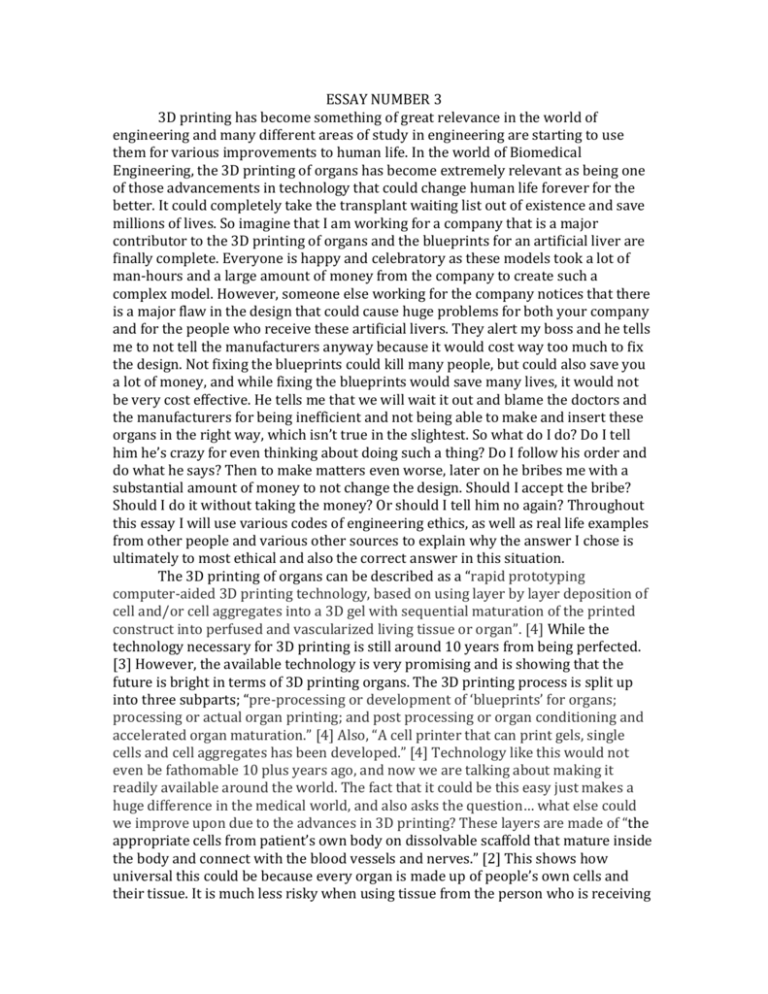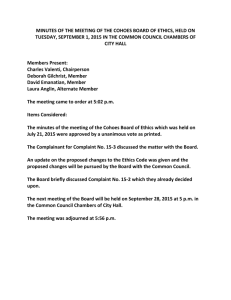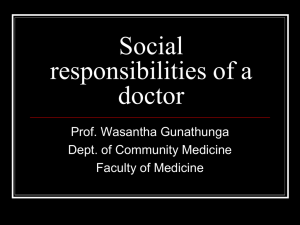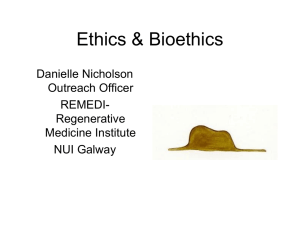Click here to view my ethical situation
advertisement

ESSAY NUMBER 3 3D printing has become something of great relevance in the world of engineering and many different areas of study in engineering are starting to use them for various improvements to human life. In the world of Biomedical Engineering, the 3D printing of organs has become extremely relevant as being one of those advancements in technology that could change human life forever for the better. It could completely take the transplant waiting list out of existence and save millions of lives. So imagine that I am working for a company that is a major contributor to the 3D printing of organs and the blueprints for an artificial liver are finally complete. Everyone is happy and celebratory as these models took a lot of man-hours and a large amount of money from the company to create such a complex model. However, someone else working for the company notices that there is a major flaw in the design that could cause huge problems for both your company and for the people who receive these artificial livers. They alert my boss and he tells me to not tell the manufacturers anyway because it would cost way too much to fix the design. Not fixing the blueprints could kill many people, but could also save you a lot of money, and while fixing the blueprints would save many lives, it would not be very cost effective. He tells me that we will wait it out and blame the doctors and the manufacturers for being inefficient and not being able to make and insert these organs in the right way, which isn’t true in the slightest. So what do I do? Do I tell him he’s crazy for even thinking about doing such a thing? Do I follow his order and do what he says? Then to make matters even worse, later on he bribes me with a substantial amount of money to not change the design. Should I accept the bribe? Should I do it without taking the money? Or should I tell him no again? Throughout this essay I will use various codes of engineering ethics, as well as real life examples from other people and various other sources to explain why the answer I chose is ultimately to most ethical and also the correct answer in this situation. The 3D printing of organs can be described as a “rapid prototyping computer-aided 3D printing technology, based on using layer by layer deposition of cell and/or cell aggregates into a 3D gel with sequential maturation of the printed construct into perfused and vascularized living tissue or organ”. [4] While the technology necessary for 3D printing is still around 10 years from being perfected. [3] However, the available technology is very promising and is showing that the future is bright in terms of 3D printing organs. The 3D printing process is split up into three subparts; “pre-processing or development of ‘blueprints’ for organs; processing or actual organ printing; and post processing or organ conditioning and accelerated organ maturation.” [4] Also, “A cell printer that can print gels, single cells and cell aggregates has been developed.” [4] Technology like this would not even be fathomable 10 plus years ago, and now we are talking about making it readily available around the world. The fact that it could be this easy just makes a huge difference in the medical world, and also asks the question… what else could we improve upon due to the advances in 3D printing? These layers are made of “the appropriate cells from patient’s own body on dissolvable scaffold that mature inside the body and connect with the blood vessels and nerves.” [2] This shows how universal this could be because every organ is made up of people’s own cells and their tissue. It is much less risky when using tissue from the person who is receiving the organ is using their own cells to make it. This also means the artificial organ will fit the person better and work better in their system. The technologies used in this new artificial organ creation is a step up from those used previously, as “Modular tissue assembly is a biomimetic alternative to traditional scaffold-based strategies, which offers many advantages for engineering whole-organ and large-tissue grafts and potentially transforms the conventional cell seeding/porous scaffold paradigm of tissue engineering” [6] In fact , “The University of Wisconsin-Madison is studying how to use polylactic acid (PLA), which is widely utilized for biodegradable packaging, as a fundamental component in implanted tissue engineering scaffolds” [7] These technologies are being further developed and should be perfected in just about 10 years. Right now they are just something in the testing stages, but soon it will be something that will revolutionize our world as we know it. Ethics defined by Dictionary.com can be described as “the rules of conduct in respect to a particular class of human actions or a particular group or culture.” [8] Engineering, no matter what type you pursue is going to involve ethics in almost every sense of the word. Whether you are communicating with other co-workers on a project, or just talking to your boss about a recent decision made by a certain company/group. The two main codes of ethics that apply to this particular situation are the NSPE as well as the IEEE Codes of Ethics. They perfectly describe some basic rules and cannons that every Engineer, and just professional worker should follow everyday in whatever you do or pursue. The first rule on the IEEE code of Engineering Ethics says that one should “accept responsibility in making decisions consistent with the safety, health, and welfare of the public, and to disclose promptly factors that might endanger the public or the environment.” [1NEWPAPER] In this situation that means that you should lean more towards the change the blueprint and send it in, as opposed to the option of just using the flawed blueprint. This is just morally the correct thing to do. It is what any sane person would do, and it would be just wrong if you said sure and just went ahead and let all those other people die. Another cannon described in the NSPE Code of Ethics says you should try to “hold paramount the safety, health, and welfare of the public ” [NSPE] Again, this is just one of those rules or cannons that just makes sense. This just seems like something so trivial. Why would you want to wish harm on one another? One could argue that you would be harming people at your workplace if you do blab about the flaw in the prototype. However, you would be harming a monumental amount of people if you did not tell about the flaw in the prototype. If 18 people die a day waiting for an organ on the transplant waiting list [1FIRSTPAPER], how would it fell to let those 18 people a day think they are getting an organ that could save their life, but instead, getting a faulty organ that kills them almost instantaneously. According to the IEEE code of ethics, one of the main cannons says one must “reject bribery in all of its forms.” [1NEWPAPER] Again, this is another reason to say no to the proposition made by my boss. Not only did he break the rules of ethics already, but now he is making it worse by adding a substantial bribe into the mix. This boss of mine is not the best at following the codes of ethics in any sense. Lastly in the NSPE Code of Ethics, the third cannon states that one must only “issue public statements only in an objective and truthful manner.” [NSPE] This would be referring to the part where he would issue a false statement saying that the cause of the patients dying was from a faulty printer or from a mistake the doctors made inserting the device. This again does not follow another cannon in the Engineering code of Ethics. The last cannon in the Code of Engineering Ethics would come from cannon number 10 in the IEEE Code of Ethics, which states that one will “assist colleagues and co-workers in their professional development and to support them in following the code of ethics.” [1NEWPAPER] This would be referring to the things you should say to your boss regarding following the Codes of Engineering Ethics and how important it is to follow this. If engineers do not act in an ethical manner, who will? From these multiple codes of ethics sources for engineers, one could see clearly that following your bosses orders would be completely out of line and unethical. Following the orders he set out or accepting the bribe he offered, would be wrong on so many levels and would go against everything we believe in as good people. On the other hand, there is more to engineering ethics than following the code. There are times when it is better if the code of engineering ethics is not followed. In this next section of my essay I will site specific examples from real life where the people involved either followed the code of ethics or ended up not following the code of ethics and whether it turned out good or poorly for them. The first example of a real world example from the 1986 NASA shuttle launch, when the project manager in charge of the shuttle construction was more interested in saving money than making the safety of the astronauts on the shuttle the priority. He told his other executives to think of this issue as a manager instead of as an engineer. This seriously cost all of them because instead of falling the code of ethics for engineers, they decided to put saving money ahead of the safety of those responsible. All of the people aboard the shuttle died after the O-rings in the shuttle came undone 73 seconds into the launch. [9] This is a real life example of going against the code of ethics and it not panning out at all. If this were my example, it would basically go the same way. I would listen to my boss and not tell anyone at the company about the flaw in the design and it would basically have the same effect as the NASA flaw. The flawed design would cause an extreme amount of time in a very short period of time, just like the failed NASA launch in 1986. The article also says that “business can create a context in which ethical behavior is not as likely to occur” [9] There are times in business when business is the most important thing, when cost efficiency would be the most important thing. However, when we are talking about people’s lives, it is time to take a step back and realize that safety is the most important thing to care about when you are talking about artificial organs or a trip to the moon. In another real world example, Barry Salzberg who is the Global CEO of Deloitte Touche Tohmatsu Limited talks about how saying no worked out perfectly twice for him. He talks about how his boss also told him to do something and he said no and it ended working out great for both parties because they succeeded in their goals as well as the fact that they followed the ethics code for engineers. [10] If I did the same thing in the situation I described, the same thing would happen. We might have to spend a little more money and use a little more man hours in the long run. But, we would not kill anyone, end up getting sued, and then maybe even shut down making everyone lose his or her jobs. The right thing to do in this situation based on the other real life situations would be to tell about the flaw because in the long run it will save them a lot of hassle. So, what would I do if I went up to my boss, told him there was a problem with a design, and he said don’t worry about it? I would calmly stand up tell him that is a terrible idea and then begin to explain why we should let everyone know about the flaw in the design. I would tell him that it is better to spend more in the long run and not break any of the cannons from the code of engineering ethics. I would also tell him that our goal as engineers is to ultimately benefit society as a whole, and our job as engineers is not to be hit men who would intentionally just let others die when there is something we could easily do to fix it. The engineering code of ethics is an important thing to follow when working in a setting where you are talking about benefiting the public in any way shape or form. You must ask yourself before you do anything in this business, is what I am doing ethically right? Would other people agree with the decisions I am making? Am I hurting anyone else by these decisions? If the answer to any of those questions is yes, than you must take a closer look and realize that there is a better solution.






